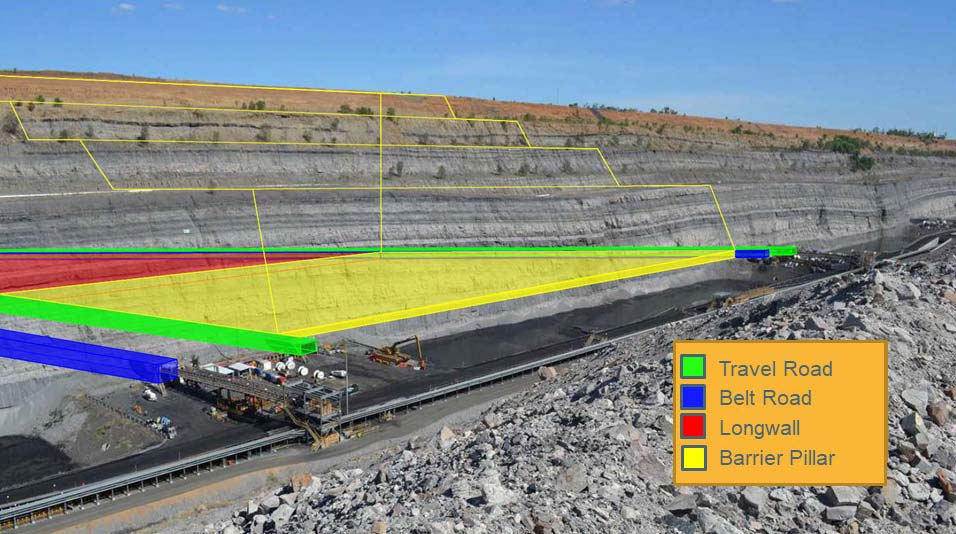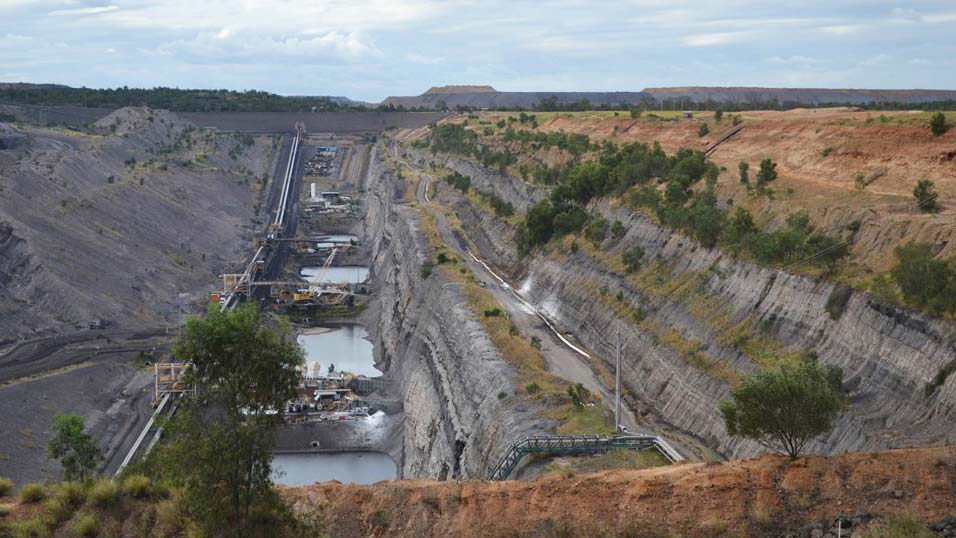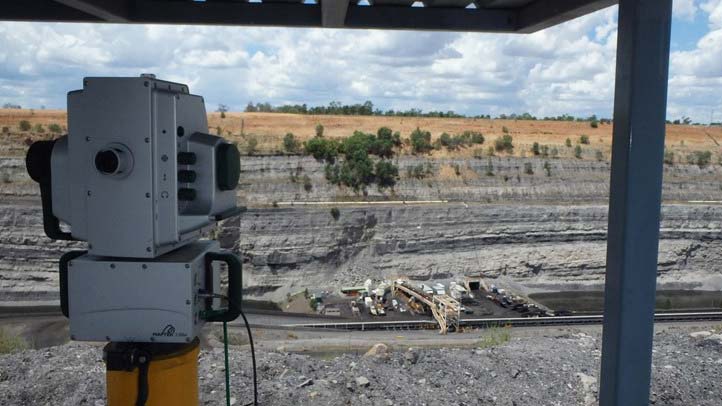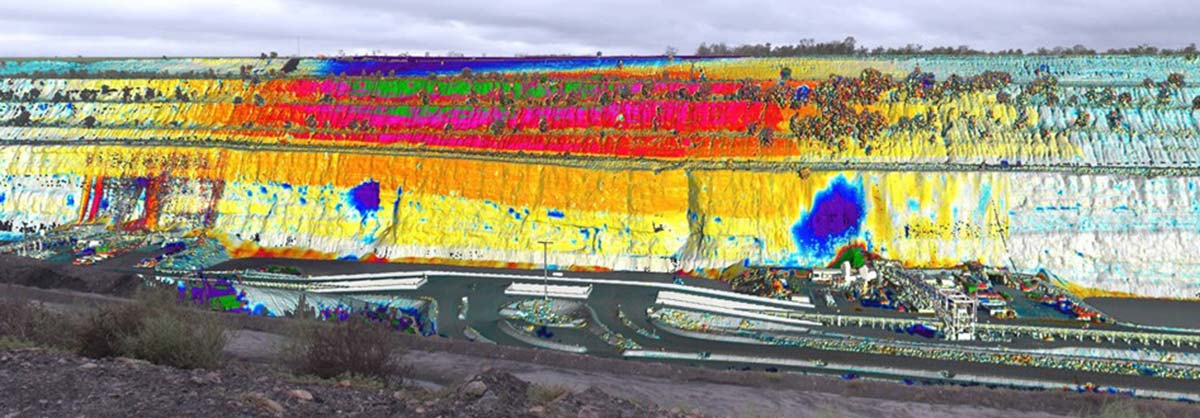June 2019 Issue Index
Highwall stability in longwall mining
The Broadmeadow coal mine in Central Queensland used Maptek Sentry monitoring to help predict highwall movement associated with longwall subsidence.
BHP Coal’s Broadmeadow Mine is one of only a few punch longwall mines in Australia. This method makes use of abandoned open cut mine strips and drives gateroads directly into the seam at the base of the highwall, with no requirement for main entries. The longwall is then retreated towards the open cut and recovered just short of the highwall, leaving a safe barrier pillar.

Broadmeadow has mined 11 longwall panels by this method, from two adjacent open cut strips. Significant highwall movement was related to the effect of subsidence when longwalls approach their final position close to the open cut highwall. The operation wanted to understand the mechanism causing the movement and potentially be able to predict instability.
Mining of longwalls under or adjacent to large voids such as stream valleys, escarpments or cliffs is commonly associated with heavily vegetated or steep areas, where survey access is limited and interpretation of any surface movement data is complicated.
The punch longwall layout provides access to deploy radar and laser scanning technology. An unvegetated, evenly excavated open cut highwall creates a perfect configuration to study the effect of longwall subsidence on a steeply dipping surface.
Background
Inclinometer monitoring adjacent to the Broadmeadow Mine LW11 panel during the start of the block confirmed that the direction of shear movement is toward the centre of the void created by the longwall panel.
Survey peg data indicated typical horizontal movement, with points drawn toward the goaf (collapsed rock above the void) as the longwall approaches and then moving in the opposite direction as the longwall passes underneath and the surface settles.
This traditional understanding led barrier pillar designers to believe that longwall subsidence would pull the highwall toward the goaf and into an even more stable position.
However, at Broadmeadow the observed highwall movement and associated ground deformation did not conform to either typical longwall subsidence profiles or highwall movement. Values far exceeded stability limits used in adjacent open cut mines, indicating the onset of failure.
This outward movement, while not affecting the global stability of the highwall, destabilised local areas around existing defects and geological structures.
Monitoring
The Maptek Sentry system was trialled alongside a radar system on LW10 and used exclusively for LW11. Both systems enabled near continuous, real-time, sub-millimetre monitoring of a full 100 m high x 500 m wide highwall.
The Maptek laser system can scan the entire wall in six minutes, depending on the block size to be monitored.

An advantage of laser technology is that it is spatially referenced, allowing itinerant monitoring. The scanner can be shifted to a new location and maintain a correlation in the data before and after moving.
Both laser and radar techniques enabled real-time graphical display of total displacement and rate of wall movement. The supporting software provided real-time triggers or warnings of increasing rate of movement, and videos of displacement over time could be created.
High quality, accurate information was generated, and large-scale highwall displacement of up to 1000 mm was measured from 300 metres.
Predicting instability
At Broadmeadow, an unprecedented magnitude and rate of movement was caused by the longwall effect (1000 mm total, with a rate up to 1.5 mm/hr over +6 weeks), and the rate was controlled by longwall retreat rather than ground failure.
Interpretation of the data requires the judgement of a geotechnical engineer to balance increased rate of movement with increased rate of longwall retreat. The ability to monitor and colour contour the entire highwall allowed identification of anomalous localised areas of movement to trigger additional protection measures.
Protection measures
Punch longwall mining increases the risk of mine inundation due to the low elevation and wide catchment area. Large levees are constructed to protect the open pit from flooding by adjacent rivers. Sumps constructed against the highwall between the headgate and tailgate portals control rainfall and rock hazards in the pit catchment. The sumps protect the working area from rockfall hazards between headgate and tailgate, but the portal areas remain exposed.
Access of personnel and materials through the portal entries requires more stabilisation on this part of the wall. The highwall is rehabilitated with rockbolts and draped with rockfall mesh. Substantial reinforced concrete portals are installed out to 15 m from the highwall to allow covered access. A 10 m exclusion zone is enforced adjacent to the portals, and a 2 m high rock bund creates a catch drain for local rockfalls. This is standard for all punch longwall portal accesses and is independent of the study results.
Design considerations
Forward movement of the highwall is theorised to be primarily caused by the subsiding ground; as the strata lies down behind the longwall, a massive forward push occurs. This is normally confined by hundreds of metres of solid ground, but when adjacent to an open cut void or stream valley, the longwall shoves the bedded ground forward like a stacked deck of cards. The maximum movement is near the surface and decreases downward due to leverage and frictional resistance from the weight of overburden and proximity to the subsidence trough.

Underground planning engineers seek to optimise barrier pillar widths, but traditional design methods may not account for highwall stability. While the global highwall stability was maintained at Broadmeadow, localised failures remobilising along joints or faults can be triggered around pre-existing geological structures, cling-ons or blast cracking.
Various controls are suggested if mining is within 300 m of an open pit:
- Scan and map highwalls prior to planning portal locations and longwall stop positions to identify all potential structures that could be affected and put specific controls in place.
- Allow space on catch benches and portal pads for adequate bunding against the slope toes to manage pit slope failures.
- Ensure that infrastructure placement on highwall benches and pads allows for potential ground movement, with concrete portal entries set further off the highwall.
- Cater for access and restricted access to catch benches.
- Catch drains should be accessible and regularly cleared to maintain capacity.
The punch longwall layout and the open cut slope stability monitoring technology provide a near-perfect scenario for monitoring the effect of highwall movement due to an approaching longwall, where subsidence will push ground forward when adjacent to a void.
Barrier pillar sizes in punch longwalls can be minimised with an understanding of the mechanism, appropriate design and deliberate controls. Additional controls can be very effective for working in close proximity to a highwall or void.
Thanks to BHP Coal Broadmeadow Mine
Edited extract of paper by
Matt Martin, Dan Payne, Bob Coutts & Dan Lynch
presented at ICGCM 2018
- The punch longwall layout provides ideal access to deploy radar and laser scanning technology
- An unvegetated, evenly excavated highwall creates a perfect configuration to study the effect of longwall subsidence on a steeply dipping surface
- Monitoring and analysing the entire highwall allowed geotechnical engineers to identify local anomalies that may require additional safety protection measures

